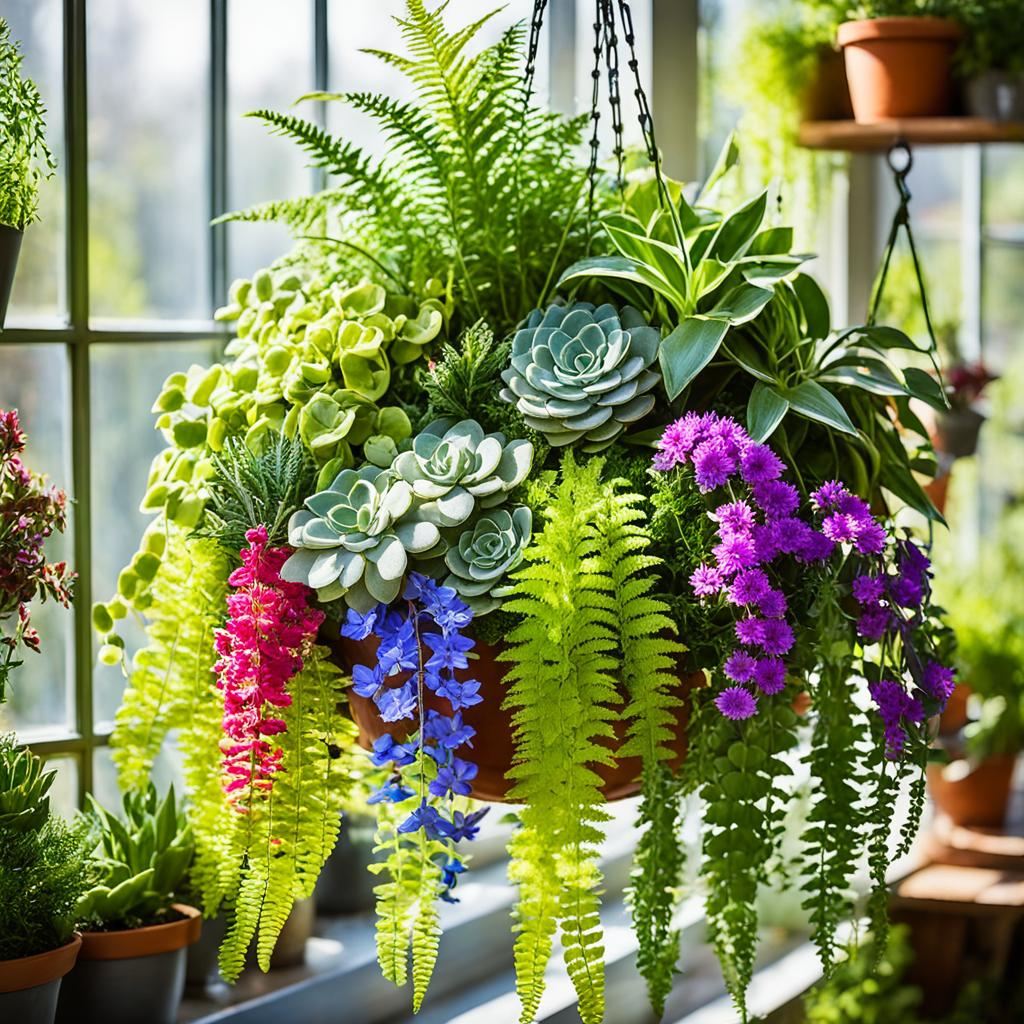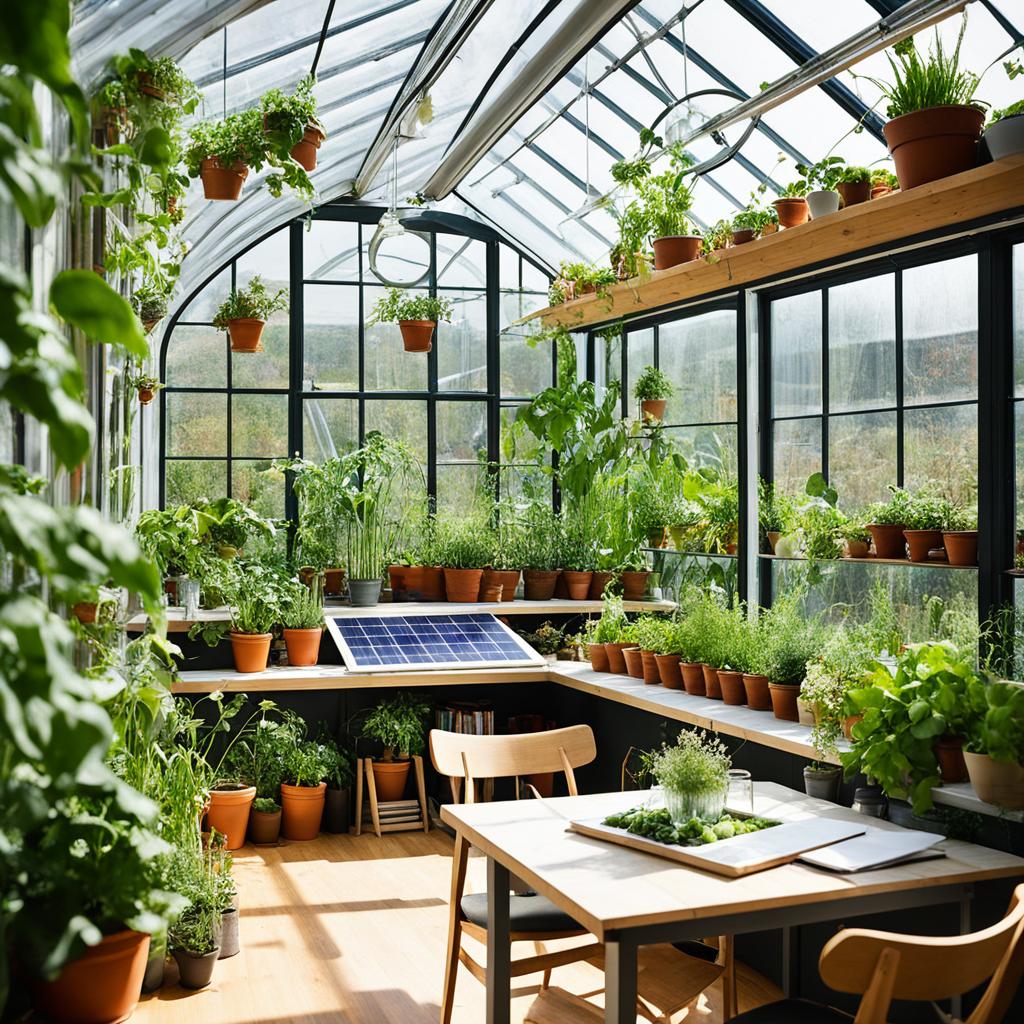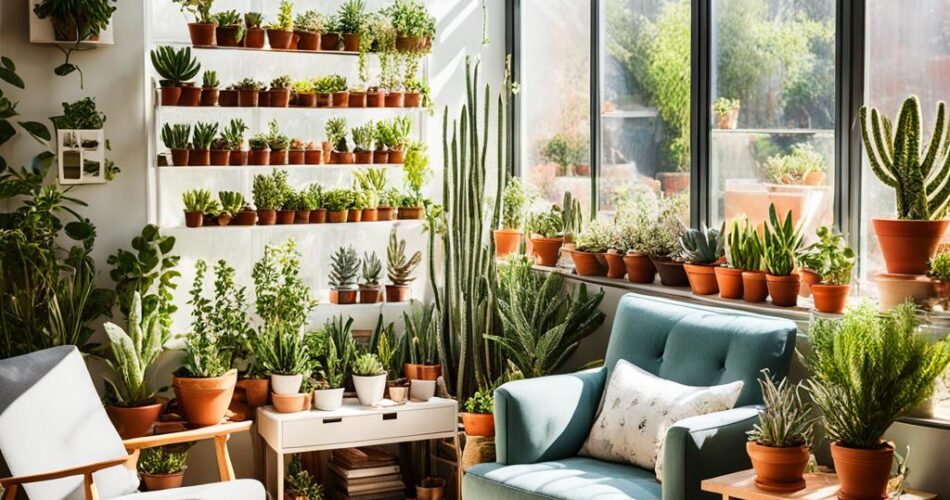Urban gardening fans, get excited! Indoor gardening is full of creative DIY greenhouse ideas. These mini-greenhouses let plant lovers care for their plants all year, no matter the weather outside. You can use old furniture or high-tech setups to create a green space in your home.
Picture taking care of tropical plants like aroids, ferns, and orchids in your own space. With some creativity, a simple IKEA Åkerbär Greenhouse can turn into a lush jungle. Or, take an old cabinet and add grow lights and humidifiers to make it a plant paradise.
DIY greenhouses are super versatile. You can grow warm-loving plants or even try growing small vegetables like Micro Tom tomatoes. By using adjustable grow lights and controlling the humidity, you create the best conditions for your plants to grow.
Key Takeaways
- Indoor greenhouses enable year-round gardening in small spaces
- DIY options range from budget-friendly IKEA hacks to custom cabinet conversions
- Tropical houseplants and dwarf vegetables thrive in controlled indoor environments
- Adjustable grow lights and humidity control are essential for optimal plant growth
- Repurposing furniture for greenhouses aligns with sustainable living practices
The Benefits of Indoor Greenhouses
Indoor greenhouses are great for plant lovers. They let you grow plants all year, no matter the weather outside. Let’s look at why these mini gardens are essential for anyone who loves plants.
Protection from Cold Weather
Indoor greenhouses keep plants safe from cold weather. Many plants come from warm places and need special care. These greenhouses are like a warm home for these plants, helping them grow even when it’s freezing.
Controlled Environment for Plant Growth
Being able to control the climate is a big deal for plants. Indoor greenhouses let you set the temperature and humidity just right. This means you can grow many types of plants, from tiny seedlings to exotic ones.

Year-Round Gardening Opportunities
Indoor greenhouses mean you can garden all year. You can grow vegetables out of season and take care of tropical plants whenever you want. This lets you garden all year, making sustainable gardening easier.
| Feature | Benefit |
|---|---|
| Temperature Control | Maintains optimal growing conditions |
| Humidity Management | Prevents plant stress and disease |
| Light Regulation | Ensures proper photosynthesis |
| Pest Protection | Reduces risk of infestations |
Indoor greenhouses are not just for plants. They also make your home look beautiful. They add a natural touch to any room, creating a calm space. Plus, growing your own food can save you money, making these greenhouses a smart choice for saving and plant lovers.
Choosing the Right Location for Your Indoor Greenhouse
Finding the perfect spot for your indoor greenhouse is crucial for plant growth. It’s all about getting the right balance of sunlight and space. This creates a great place for your plants to thrive.
Windowsills are great for small gardens. They get plenty of natural light, perfect for herbs and small plants. For bigger gardens, think about using a spare room or basement for your grow room setup.

- Sunlight: South or southeast-facing windows offer the most natural light
- Space: Ensure enough room for plants to grow and for you to work
- Temperature: Avoid drafty areas or spots near heating vents
- Accessibility: Choose a spot that’s easy to reach for daily care
If you’re short on space, try vertical gardening. Use wall-mounted shelves or hanging planters for your windowsill gardens. These are perfect for small apartments.
| Location | Sunlight | Space | Ideal Plants |
|---|---|---|---|
| South-facing window | High | Limited | Succulents, herbs |
| East-facing window | Moderate | Limited | Leafy greens, ferns |
| Spare room | Varies | Ample | Various, including larger plants |
| Basement | Low | Ample | Shade-loving plants, with grow lights |
If you don’t get much natural light, grow lights can help. With the right planning, any spot in your home can become a thriving indoor greenhouse.
DIY Indoor Greenhouse Ideas
Creating your own indoor greenhouse lets you explore new gardening options. You can upcycle everyday items or repurpose furniture to bring nature inside. This makes your home greener and more beautiful.
Repurposed Container Greenhouses
Using recycled materials is a green way to garden indoors. Meredith Bishop, a pro in sustainable flowers, suggests using plastic containers from strawberries or grapes. These mini greenhouses are great for starting seeds and can go outside when it gets warmer.

Glass Cabinet Conversions
Glass cabinets work well as indoor greenhouses. Annette Hird, an expert in urban gardening, says to line them with plastic for the best growing conditions. The IKEA Fabrikor cabinet is a top pick for DIY fans. It’s both a useful greenhouse and a stylish piece of furniture.
Window-Mounted Mini Greenhouses
Window greenhouses use natural light well and don’t take up much space. A mini kit for your windowsill lets you grow organic plants easily. These kits come with covers, peat pellets, and plant food.
For those who love to get creative, there are many upcycling projects. You could turn a thrift store glass lantern into a cute greenhouse. Or, try a 3D-printed base for a Ball Mason jar from Etsy sellers for a modern look.
Choosing a repurposed container, converting a glass cabinet, or going for a window-mounted option, these DIY ideas let you grow plants all year at home.
Essential Components for Your Indoor Greenhouse
Creating the perfect indoor garden takes careful planning and the right gear. Let’s look at the main parts that make a thriving indoor greenhouse.
Grow Lights
LED grow lights change the game for indoor gardening. They give plants the light they need to grow well, even in dim spots. These lights use less energy and produce less heat, perfect for small spaces.

Humidity Control
Keeping the right moisture level is key, especially for tropical plants. Humidifiers are crucial for creating the ideal setting. They stop leaves from drying out and help plants grow strong.
Temperature Regulation
Keeping your indoor garden at the right temperature is key. Ventilation systems help control the temperature and air flow. In the cold, you might need extra heating to keep your plants warm.
| Component | Function | Benefit |
|---|---|---|
| LED Grow Lights | Provide artificial light | Energy-efficient, low heat output |
| Humidifiers | Increase moisture levels | Prevent leaf drop, promote growth |
| Ventilation Systems | Regulate air flow | Manage temperature, prevent mold |
With these key parts, you’ll set up a great place for many plants to grow. The secret to success is watching and tweaking these elements for your plants’ needs.
Selecting Plants for Your Indoor Greenhouse
Choosing the right plants for your indoor greenhouse is crucial for a thriving green oasis. Your selection should match your space’s unique conditions and your personal taste. Let’s look at some popular options that do well in your indoor garden.

Tropical houseplants are great for high-humidity spaces. Ferns, orchids, and aroids enjoy the moist air and steady temperatures. For those who love to eat, herb gardens are ideal. Basil, cilantro, and mint grow well in greenhouses, offering fresh flavors all year.
For an indoor vegetable garden, start with salad greens. Spinach and lettuce are favorites among greenhouse gardeners. They grow fast and don’t take up much room. Adding strawberries or cherry tomatoes brings color to your garden.
Succulents and cacti are perfect for drier, bright greenhouses. These plants are easy to care for and add interesting textures and shapes. If space is tight, microgreens are a great choice. They grow fast and are packed with nutrients.
- Leafy greens: Spinach, lettuce, kale
- Herbs: Basil, cilantro, oregano, mint
- Fruits: Strawberries, grapes, figs
- Ornamentals: Orchids, African violets, begonias
- Desert plants: Cacti, aloe, agave
The secret to a successful indoor greenhouse is variety. Try different plants together to make a lively, thriving space. This will bring you joy and fresh produce all year.
Step-by-Step Guide to Building a Glass Cabinet Greenhouse
Building a DIY greenhouse cabinet is a fun project that brings nature indoors. This guide will show you how to turn upcycled furniture into a plant sanctuary.
Finding the Perfect Cabinet
Start by looking for a glass-front cabinet. The IKEA Milsbo is a top choice for greenhouses but often sells out fast. Thrift stores and online marketplaces are good places to find upcycled furniture.
Gathering Materials
Here are the key items you’ll need for your DIY greenhouse cabinet:
- LED grow lights (strip or hanging)
- Mini humidifier
- Small USB fans (one per shelf)
- Temperature/humidity meter
- Wire shelves for better airflow
- Weather-stripping tape
Preparing the Cabinet
Clean the cabinet well. If it needs it, seal and varnish it to fight moisture. Swap out glass shelves for wire ones for better air flow. Use weather-stripping tape to seal gaps, keeping humidity at 75-80%.
Installing Grow Lights and Humidifiers
For grow lights, attach LED strips to glass shelves or hang full-spectrum lights. Put a mini humidifier inside for the right humidity. Add small fans at each shelf for air flow. Drill holes for ventilation and cable management if needed.
“A well-designed greenhouse cabinet creates the perfect microclimate for tropical plants to thrive.”
With your DIY greenhouse cabinet ready, fill it with plants like Philodendrons, Monsteras, and orchids. Keep an eye on the temperature and humidity for your plants’ health.
Maintenance and Care for Your Indoor Greenhouse
Keeping your indoor greenhouse healthy needs regular care. A well-kept environment helps plants grow strong and gives you lots of harvests all year. Let’s look at key tasks to keep your greenhouse perfect.

Begin with a steady watering plan. Each plant needs different amounts of water. Use a moisture meter to check soil moisture and avoid giving too much water, which can cause root rot.
It’s important to watch for pests in your greenhouse. Check your plants often for any signs of pests. Use natural ways to control pests, like neem oil or helpful insects, to keep bugs away.
Pruning is crucial for plant health. Cut off dead or yellow leaves and trim branches that are too long. This helps with air flow, stops diseases, and encourages new growth.
Fertilizing gives plants the nutrients they need. Feed your plants with a balanced, water-soluble fertilizer every two weeks when they’re growing. Change how often you fertilize based on the type of plant and its stage of growth.
| Maintenance Task | Frequency | Tips |
|---|---|---|
| Watering | Every 2-3 days | Check soil moisture before watering |
| Pest Inspection | Weekly | Use natural pest control methods |
| Pruning | Monthly | Remove dead leaves and overgrown branches |
| Fertilizing | Bi-weekly | Use balanced, water-soluble fertilizer |
Don’t forget to clean your greenhouse often. Clean surfaces with mild soap and warm water to stop mold from growing. This keeps a healthy place for your plants to grow in your indoor garden.
Space-Saving Indoor Greenhouse Solutions
Urban dwellers often face the challenge of limited space for gardening. Luckily, there are innovative ways to make the most of your space. Let’s look at some clever ideas and designs for indoor greenhouses.
Vertical Gardening Techniques
Vertical farming is a big change for small gardens. Using wall-mounted shelves and hanging planters turns bare walls into green spaces. Living walls and trellises for climbing plants add nature to your home and save space.

Shelving solutions are great for vertical gardening. You can use tiered stands or old ladders to create growing spaces. Here are some creative ideas:
- Convert a coffee table into a mini greenhouse
- Use dollar store photo frames to build a small garden
- Transform a pastry display case into a chic planter
Compact Greenhouse Designs
For those with limited space, compact greenhouse designs are perfect. Mini greenhouse kits and collapsible structures are easy to use and flexible. Here are some options:
- Repurpose a glass cabinet, like IKEA’s Fabrikor, into a stylish indoor greenhouse
- Create a Mason jar terrarium with a 3D-printed base for a modern look
- Use a miniature lantern as a decorative mini greenhouse
If you have a bit more room, turning a spare bedroom into a plant room can feel like having a greenhouse. Don’t forget to add grow lights and humidity control for your plants.
| Greenhouse Solution | Space Required | Plant Capacity |
|---|---|---|
| Windowsill Kit | Minimal | 5-10 small plants |
| Vertical Garden | Wall space | 20-30 plants |
| Glass Cabinet | 2-3 sq ft | 15-25 plants |
| Converted Room | 50-100 sq ft | 50+ plants |
By using these space-saving ideas, you can garden all year, no matter your living situation. Whether you choose vertical farming or compact greenhouses, be creative and use your space wisely.
Eco-Friendly and Sustainable Indoor Greenhouse Practices
Indoor greenhouses are great for sustainable agriculture and organic gardening. With more people growing houseplants, it’s vital to use eco-friendly methods. These methods help lessen our impact on the environment.
Water conservation is crucial in indoor gardening. Use self-watering systems to cut down on waste and make sure plants get the right moisture. Also, use rainwater for irrigation to lessen your water usage.

Being energy efficient is also key. Pick LED grow lights with timers to use electricity wisely. These lights give plants the light they need for photosynthesis but use less power than old-style lights.
Go for organic gardening by using natural fertilizers and pesticides. This helps your plants and cuts down on harmful chemicals. Think about composting kitchen waste to make rich soil for your indoor garden.
“Small changes in our gardening habits can lead to significant environmental benefits.”
Upcycling is a smart way to be sustainable. Use old items as planters or parts of your greenhouse. This saves money and cuts down on waste. For instance, use recycled cans or things that break down easily for your plants.
| Sustainable Practice | Environmental Benefit |
|---|---|
| Self-watering systems | Reduces water waste by 30-50% |
| LED grow lights | Uses 75% less energy than incandescent bulbs |
| Organic fertilizers | Decreases chemical runoff by 90% |
| Upcycled containers | Diverts 5-10 lbs of waste per household annually |
By using these sustainable methods, your indoor greenhouse can be a green gardening example. It helps make a greener future and gives you a place full of thriving plants.
Conclusion
Indoor greenhouses are great for garden lovers. They let you grow plants all year, giving you fresh produce even when it’s cold outside. These spaces keep humidity just right, between 50-70%, perfect for plants.
Building your own greenhouse can be fun and save money. You can use old glass cabinets or make a small one for your window. Making your own greenhouse is cheaper than buying a kit, and using old tools cuts costs even more.
Adding green living to your indoor garden is easy. Use drip irrigation and collect rainwater to save water. Add solar panels for energy savings and to control the temperature. With careful planning and upkeep, indoor greenhouses are a green way to grow plants all year, no matter the weather or space.
